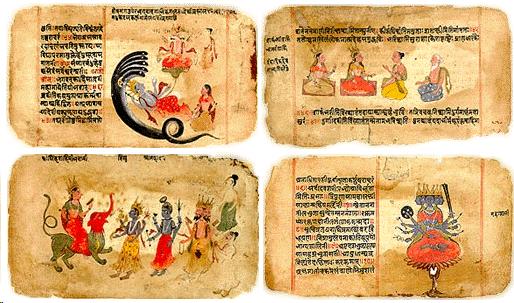
The Vedic Period

A colorful rendition of the Vedas
In this part of our lecture, I want to highlight five important characteristics of the first stage in the development of ancient Hinduism. First, the Vedic period is the period of the Aryan invasion which historians date to approximately 1500 BCE. Second, the period is named "Vedic" for the set of hymns that the Aryans wrote, in which they set forth their fundamental beliefs about the nature and order of the world and universe: the gods, the creation of the world, the role of man, etc. Originally these hymns were transmitted orally, but were eventually written down. They laid out various prayers to and songs about the gods and described various ritual practices that have come to define Hindu worship. The Vedas outline the Aryans' transition from the belief in a distant parent god to the belief in a group of more functional, anthropomorphic gods. Vedic religion was kathenotheistic, which means that Hindus believe in different gods but, when offering prayers or sacrifice to a particular god, they tend to treat that god as if it were the only one. For example, if the hymn was about Indra (the warrior god, described below) then Indra was spoken about as the most important or even the only god. But if the hymn was about Agni (the god of fire, also described below) then he was spoken about as the most important or only god. Third, the Vedas speak of many gods, but among those there were three major deities about which we will talk briefly: 1) Indra - Indra was a violent warrior god who was believed to have made possible human existence. Indra is believed to have killed a giant snake who encircled all the water in the world atop a mountain (making it inaccessible to the rest of the world). By slaying the snake and freeing the waters Indra provided humans with the water necessary for life. As he was believed to be a fierce warrior, he was often called to protect warriors when it came time for battle. 2) Varuna - Varuna was the god of moral and natural order, and was in some sense more important or highly placed than Indra. Varuna makes the world orderly without struggle, whereas Indra needed physical violence to liberate the waters. Laws that needed to be obeyed, whether moral or describing how the world works physically, were Varuna's responsibility. 3) Agni - Agni was the god of fire. Fire was central to the Vedic religion because of its cleansing power, and played a major part in Vedic ritual. Fire played a crucial role in the lives of primitive peoples, because it was responsible for all the most significant technologies (primarily weapons, whether made of bronze or iron) and the cooking of food. Also, fire can transform the physical world, and became a symbolic mediator between the human and the divine. Agni, as the god of fire, also became the god of priest (who also served as mediators between the human and the divine). The fourth characteristic of the Vedic period is that the Vedic religion was a religion of sacrifice. Sacrifice served as a way to placate the gods and keep them "happy". The centrality of sacrifice meant that priests held a particularly esteemed place in Hindu society, as we saw in the previous lecture, as they were the ones to perform the ritual sacrifices that kept the gods content (and therefore amenable to mankind). Sacrifice developed over time from blood sacrifice (of animals) to asceticism, or the ideal of self-sacrifice (that is, denying one self pleasures and luxuries, and sometimes even basic necessities, all in the name of the gods). Lastly, note that the beliefs set forth in the Vedas were later developed further in a second group of hymns, the Upanishads. The Upanishads are, in general, more "intellectualized" than the Vedas. Where the Vedas focus on ritual and prayer, the Upanishads concentrate on the meaning behind various rituals and prayers. It is in the Upanishads, then, that the basic tenets of Hinduism are explained.